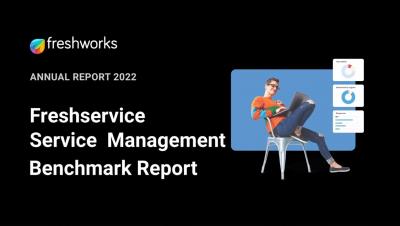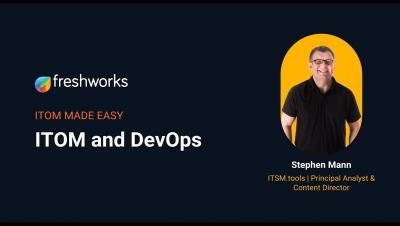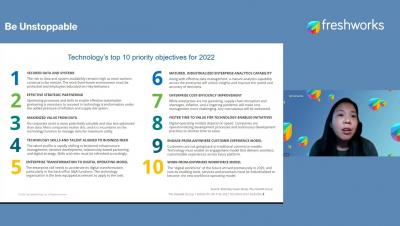Operations | Monitoring | ITSM | DevOps | Cloud
May 2022
How IT leaders can make the leap from tech leaders to business drivers
Today, there is a need for every business to be digital, and technology as you know it lies at the heart of every business. Determining technology’s role in enabling and driving business success has always been a top priority for IT leaders. But these days, IT leaders are also faced with the added pressure of adjusting to the recent economic and societal changes, namely, remote work and employee mobility, to drive viable business results.
The evolving partnership between business and IT: A new imperative
The role and perception of IT have changed from a cost center to a revenue driver. Today, businesses that lean into IT to drive business transformations stand a better chance of appealing to their end-users than those that don’t. As the scale, pace, and impact of technological disruptions and innovations escalate exponentially, the action of IT leaders, such as yourselves, will largely determine the success or demise of a business.
ITOM and DevOps | IT Operations Management | ITOM Made Easy 2/5
Why happy employee experience means happy customer experience
Peanut butter and jelly are two great condiments on their own but pairing them together elevates the sandwich game to a whole other level. That’s pretty much the case with employee experience and customer experience. When organizations pair EX and CX together and channel their efforts to keep both ends of the spectrum happy and delighted, the end result is the sweet and salty aftertaste of PB&J in the form of lower employee turnover and higher customer satisfaction.
What are the top priorities for tech leaders in 2022?
The high penetration of cloud-based applications and the Great Resignation that shows no sign of slowing down makes technology the differentiator for organizations, stressing the need for uninterrupted IT now more than ever. As Christopher Kay from the Hackett Group rightly pointed out in a session at the Be Unstoppable virtual summit, delivering a great employee experience at the workplace is the linchpin for organizations to fight the battle against the Great Resignation.
What is ITOM? | IT Operations Management Explained | ITOM Made Easy 1/5
4 Key ITSM Trends for 2022 | ITSM Trends | CIOs
Employee Experience - The New Competitive Advantage Driven by IT | EX | ITSM | ESM
The First Step to Delivering Unstoppable Business with Uninterrupted IT
Forrester Perspective: State of Uninterrupted Enterprise Service Management | ESM
ITOM | Anywhere Operations - An Operational Mindset to Remain Uninterrupted and be Unstoppable
Top 10 Priorities for Tech Leaders in 2022 | IT Leaders | CIOs
Building an 'anywhere operations' mindset for uninterrupted IT
Given a choice, would you rather wait for a cab ride that’s 25 mins away or look for other options to reach your destination faster? Without a doubt, you would pick the latter, right? Today’s ‘want-it-now’ consumer mentality is driving most technology organizations to rethink how they interact with employees and customers. Employees have consumer-grade expectations for corporate applications, and IT requests at the workplace.
5 reasons an IT service desk is not just for IT teams
When the capabilities of IT service management are applied to other business functions like HR, Finance, Facilities, Legal, Sales, or Marketing to improve service delivery, it is known as ESM (Enterprise Service Management)
How to gauge the maturity of your IT operating model?
Like most things that are changing and challenging our way of living, the accelerating change in unfamiliar customer behaviors disrupted supply chains, and diverse regional responses are challenging the traditional IT practices. To address these adverse circumstances that are stressing current operating models, companies must envision and execute new experiences, and digitally express their brand values to customers and employees by meeting their needs at relevant points of engagement. How?
5 ways to become an effective enabler of IT service management
The business needs of IT Service Management (ITSM) are evolving, and I&O leaders must take sufficient action to position their ITSM practices as an enabler of digital business instead of a bottleneck. A recent Gartner report on the 2022 Strategic Roadmap For IT Service Management states, “By 2024, 80% of ITSM teams that have not adopted an agile approach will find that their ITSM practices are ignored or bypassed.”
Enterprise Service Management: A key ingredient to uninterrupted IT
A never-ending global pandemic and the Great Resignation that shows no sign of slowing down, have made one thing very clear. In order to sustain in a volatile environment such as what’s being witnessed, organizations must level up their IT game to ensure the business runs smoothly and deliver a delightful employee experience every step of the way. To simply put, uninterrupted IT is the need of the hour for unstoppable business.
Leverage these 6 features of your ITSM tool to improve employee experience
With a paradigm shift to hybrid work practices and remote working, some critical questions arise. Firstly, how can organizations optimize employee engagement by using service management technology and principles? Secondly, how to digitize processes and assets? Thirdly, and most importantly, how to keep operations running in a world where the ‘work-from-anywhere’ workforce model is prevalent?
Automated Alert Grouping: Resolve incidents faster with richer context
According to a study, an average organization logs about 1200 IT Incidents per month out of which 5 will be critical. Given the increase in complexity of digital infrastructure, an incident is likely to impact multiple resources and services generating a ton of alerts. The mean time to repair for critical incidents is 5.81 hours, which reduces if there are fewer incidents to manage in the first place.













